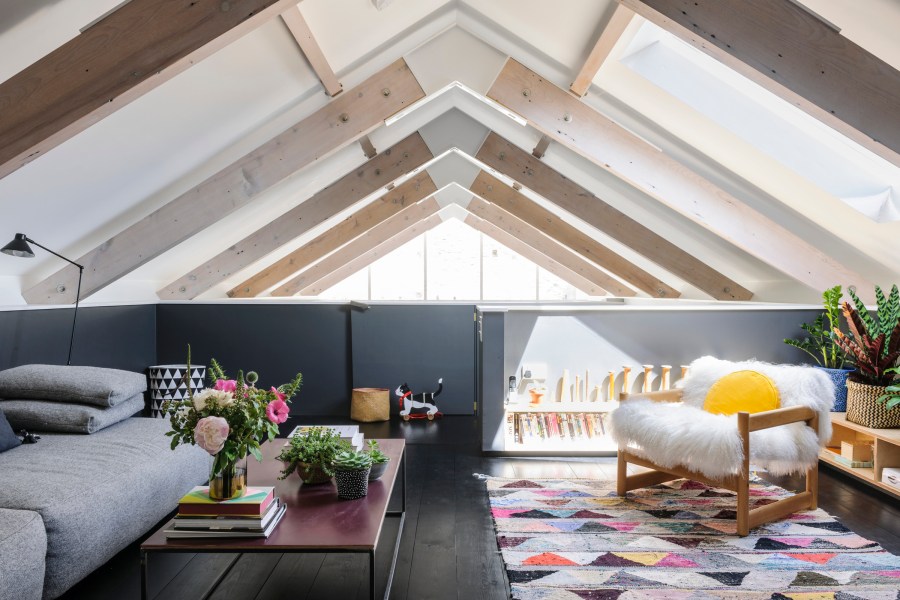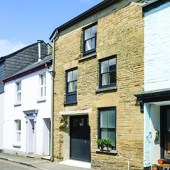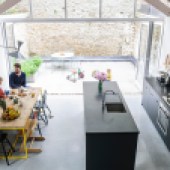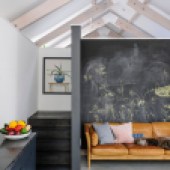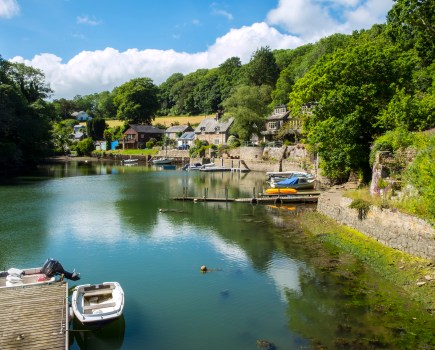By re-modelling a neglected, historic malthouse in Kingsbridge on the South Devon coast, Misha Smith and Lucy Voice have succeeded in creating a light-filled, contemporary family home. Words: Alex Reece Photographs: Jason Ingram
Walking down a backstreet in the estuary town of Kingsbridge in South Devon, you might pass an unassuming terraced cottage built of mellow local stone. What you won’t see from the pavement, however, is how this 200-year-old former malthouse has been completely re-imagined inside by its owners Misha Smith and Lucy Voice, to create a cutting-edge family home, complete with split levels, polished concrete floors, cantilevered steel stairs and glimpses of the town’s rooftops and seagulls through the skylights and floor-to-ceiling windows.
‘I like the fact that behind the facade there’s something unexpected,’ says Misha, an architect who grew up in nearby Totnes, while chef Lucy is originally from Dartmouth. ‘Having grown up by the sea, I find living here very calming,’ she adds. ‘And our kids love it, too – we’re giving them the same kind of childhood that we had.’
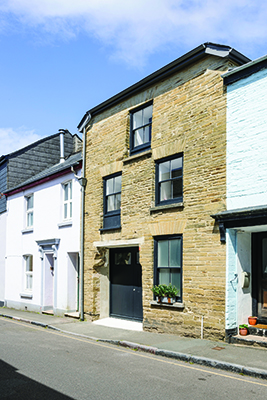
When they first came across the property in 2013, the couple were working and renting in London. But after the arrival of their first child, Lucy in particular was keen to return to the South Devon coast to be nearer to family. ‘We wanted the children to have those close connections,’ she says. At the time, the unlisted building had lain empty for five years, and was damp and dark with no outside space. Having first been built as part of the town’s Phoenix Brewery, it had served various commercial purposes over its long history – as a store for bottles and building materials, for example – and latterly had housed various small business units.
Despite its unloved state, the pair saw the potential to do something interesting architecturally: ‘Opportunities like this don’t come up often in the area,’ says Misha, who began sketching ideas of how to bring more light and air into the site. As Kingsbridge, which is close to beaches yet slightly off the beaten tourist track, was still comparatively affordable for the South Hams, it seemed too good a chance to miss. And so by October that year, the property was theirs.
You may also like Discover a Boathouse Bolthole in Devon
ANCIENT & MODERN
Having weighed up the costs, Misha took the decision to quit his job (at architectural practice Rogers Stirk Harbour + Partners) to manage the building project himself, and the family left London just after planning consent came through for his concept in early 2014.
Fortunately, Misha already had some hands-on experience, having laboured on building projects and in a boatyard between school and university. ‘I got into architecture because of my interest in building and making,’ he explains. Nevertheless, it was a large undertaking, involving an average of five men working on site for 16 months. Together, they removed the asbestos cement roof, stripped out all the floors, replaced every window and door, and demolished part of the structure to create a first-floor garden room to the rear and, later, an entrance yard to the side.
Wherever possible, original features were preserved – such as the characterful stonework, which local stonemason John Watson spent the best part of a year restoring. And when the original roof timbers proved too rotten and woodworm-ridden to be re-used, principal carpenter Jim Woodyer planed the original floor joists to create an alternative that was in keeping. Misha is particularly proud of the roof – an engineering challenge – where custom-made steel brackets and reclaimed beams elegantly combine the building’s heritage with modern industrial chic.
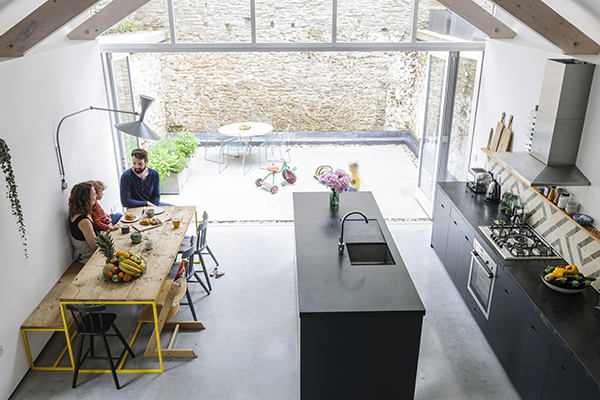
It’s a theme that continues throughout: the black steel stairs, which Misha co-designed with his engineer friend Andrew Johnson at Arup Sydney and installed himself, look entirely in context within this former working building. Another clever new addition was the split-level floor plan: a second-floor mezzanine in the loft has stairs leading down either side
to double-height spaces in the kitchen and master bedroom. The gable end in the kitchen/diner is now fully glazed and retractable, leading out onto the newly created courtyard.
Consequently, light floods the interior from all sides, including from above through light wells and skylights. ‘I’m pleased that we’ve managed to make it feel quite open and airy,’ says Misha, who cites repairing the extensive stonework as being one of the few unexpected costs. ‘The build itself actually went quite smoothly.’
You may also like Building a Dream Home in Dorset
A SELF-MADE HOME
While the project was ongoing, the couple were living with Misha’s mum in Dartington. ‘And during that time we had another baby as well,’ laughs Misha as he recalls this eventful time in their lives. Once the three-bed home was safe to live in, from late April 2015, the family took up residence. At this point, Misha also returned to work at RSHP in London, while continuing to complete the house in his spare time.
Lucy, who has a good eye for materials and finishes, had considerable input into the fit-out. For example, she and Misha cast the stylish concrete worktops for the kitchen together. The self-made aspect of the fixtures and furnishings helped both to keep costs down and to add individuality – after building the kitchen units with the carpenter Jim, Misha re-purposed some of the original floorboards to create the dining table and bench. He also made all the beds for the house, pairing them with brightly coloured furniture legs sourced online by Lucy.
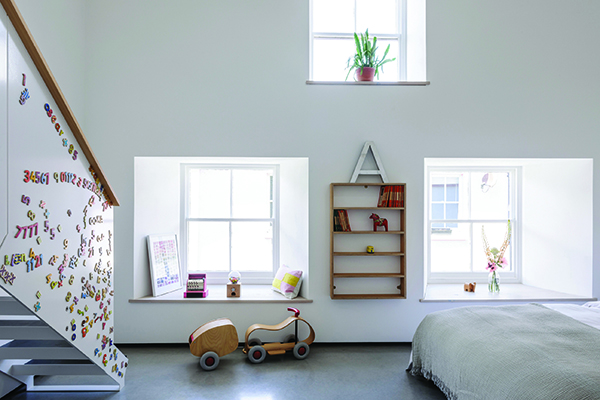
Witty home accessories, such as vintage toys Lucy has picked up in charity shops and on eBay, along with graphic prints and pastel linens, generate an upbeat, family-friendly feel in the mezzanine and master bedroom. And the resident cactus – named Pietro, after a colleague of Misha’s – has become a leitmotif for the overall decorative scheme. The spiny plants appear on ceramics, bedlinen and lined along a shelf in the family bathroom. Meanwhile, on the gallery-white walls, paintings by local artist James Stewart are displayed to striking effect.
THE LIVING IS EASY
Along with the convivial flow of the living space, the town-centre location and easy access to the seaside have brought much to family life. ‘I absolutely love it here,’ says Lucy. ‘It’s very friendly, everything’s really convenient, and we’re so close to the sea.’ In their downtime, she and Misha – who enjoys sailing and kitesurfing – take the children on coastal walks, go crabbing at Dittisham and have barbecues on the local beaches. ‘Being a chef, I really love living close to so many great producers,’ Lucy adds. ‘There’s a farmer’s market in town and lots of useful shops – Kingsbridge is a proper town rather than a holiday place.’
In the future, they hope to offer B&B accommodation in the as yet unrenovated ground floor, which has space for two bedrooms (alongside a workshop, laundry and garage), enabling Lucy to use her culinary skills in a home environment. ‘I have a little dream that we could have a back-street café downstairs, too, where I can cook,’ says Lucy.
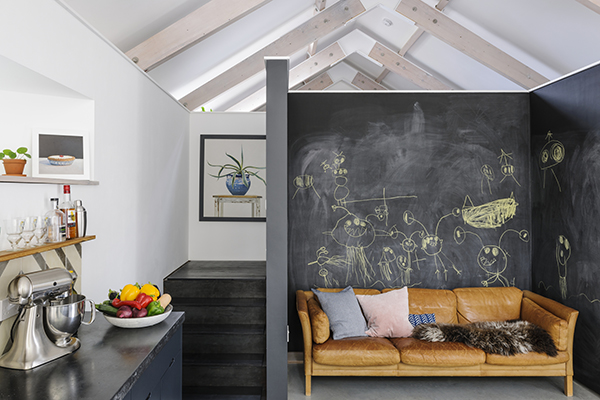
For now, Misha’s work commitments are taking the family abroad for a couple of years, during which time The Malthouse will be available to let (see details below). The creative couple look forward to realising their plans for the final phase of development on their return. ‘Part of the reason for doing the project, and doing so much ourselves, is that both of us enjoy the process,’ says Misha. ‘I feel like we’ve learned a lot over the past two years and I’d love to do it again.’
To find out about The Malthouse, visit malthou.se
Discover more seaside homes in our Design & Interiors section, or pick up a copy of the magazine.
MISHA & LUCY’S KINGSBRIDGE WEEKEND
• Our favourite local beach is South Milton Sands (nationatrust.org.uk/south-milton-sands). It’s about 10 minutes by car and has a really nice café set back from the beach that does good food (01548 561144, beachhousedevon.com).
• For eating out, we like to go to The Crabshell Inn in Kingsbridge, which is right on the river – you can watch people paddleboarding outside (01548 852345, thecrabshellinn.com). There’s a great bakery and café called The Almond Thief in Totnes, which is a 20-minute drive. They make sourdough bread, which is amazing, and sell lovely coffee (01803 411290, thealmondthief.com).
• We do loads of coast walks, and you can get all the way from Bantham to Thurlestone and Hope Cove on the South West Coast Path (southwestcoastpath.org.uk). If you keep going you eventually get to Salcombe and it’s all stunning.
• A cool thing to do with kids is to take the sea tractor at Bigbury-on-Sea to Burgh Island. There’s a lovely pub, The Pilchard Inn, on the other side (01548 810514, burghisland.com). The whole experience is special, and you can walk up to the top of Burgh Island and get an incredible view.
• For a grown-up day out, have lunch at the Anchorstone Café in Dittisham (01803 722365, anchorstonecafe.co.uk) then catch the ferry to Greenway, once home to Agatha Christie and now owned by the National Trust.

